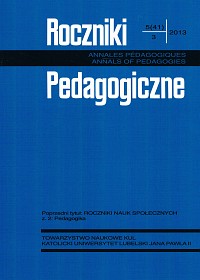Poznawcze możliwości uczniów z wadą słuchu a ich integracja w szkołach ogólnodostępnych
Main Article Content
Abstrakt
Pytanie o możliwości poznawcze uczniów z wadami słuchu jest jednym z ważniejszych problemów surdopedagogiki. Na przestrzeni lat odpowiedzi na to pytanie były różnorodne. Początkowo wadę słuchu utożsamiano jednoznacznie z brakiem zdolności intelektualnych, natomiast badania z ostatnich lat wskazują, że także w tej populacji są osoby o wysokim ibardzo wysokim potencjale intelektualnym.
Celem tego artykułu jest przedstawienie współczesnych badań w zakresie możliwości intelektualnych uczniów z wadami słuchu i wskazanie na ich konsekwencje dla integracji edukacyjnej tej grupy uczniów. Zaprezentowane badania pokazują, że uczniowie z wadami słuchu na ogół dysponują potencjałem, który powinien pozwolić im na dobre intelektualne funkcjonowanie wśród słyszących rówieśników. Warunkiem jednak sukcesów w zakresie integracji edukacyjnej jest udzielanie uczniowi z wadą słuchu systematycznego i kompetentnego wsparcia edukacyjnego i społecznego od wczesnych lat życia.
Article Details
Bibliografia
Astington J. (2001): The future of theory-of-mind research: Understanding motivational states, the role of language, and real-world consequences. „Child Development” 72, s. 685-687.
Courtin C., Melot A.M. (1998): Development of theories of mind in deaf children. W: M. Marschark, N.D. Clark (eds.), Psychological perspectives on deafness (vol.2, s.79-102). Mahwah, NY: Lawrence Erlbaum.
Csányi Y. (1994): Słuchowo-werbalne wychowanie dzieci z uszkodzonym narządem słuchu. Model węgierski. Warszawa.
Czajkowska-Kisil M. (2008): Pułapki metodologiczne w badaniach PJM. W: Stan badań nad Polskim Językiem Migowym (s.11-16). Łódź: Polski Związek Głuchych.
De Villiers P.A., Pyers J. (2000): Complementation and false-belief representation. W: Proceedings of the VIIIth International Congress for the Study of Child Language, Spain.
Dunn J. (1994): Changing minds and changing relationships. W: C. Lewic, P.Mitchell (eds.). Origins of an understanding of mind (s. 297-310). Hove, England: Erlbaum.
Dunn L.M., Dunn L. (1981): Peabody Picture Vocabulary Test, Revised edition. Circle Pines, MN: American Guidance Service.
Emmorey K., Klima E., Hickok G. (1998): Mental rotation within linguistic an nonlinguistic domains in users of American Sign Language. „Cognition” 68, s.221-246.
Furth H.G. (1966): Thinking without Language. Psychological Implications of Deafness. New York: The Free Press.
Gałkowski T. (1976): Psychologiczne aspekty głuchoty w audiologii. W:T.Gałkowski, I. Kunicka-Kaiser, J. Smoleńska (red.), Psychologia dziecka głuchego (s.5-41). Warszawa: PWN.
Geers A. (2006): Spoken language in children with cochlear implants. W: P.E.Spencer, M. Marschark (eds.), Advances in spoken language development of deaf and hard of hearing children (s.244-270). New York: Oxford University Press.
Gordon A.C., Olson D.R. (1998): The relations between acquisition of a theory of mind and the capacity to hold in mind. „Journal of Experimental Child Psychology” 68, s. 70-83.
Krakowiak K. (1995): Fonogesty jako narzędzie formowania języka dzieci z uszkodzonym słuchem (Komunikacja językowa i jej zaburzenia, t.9). Lublin: UMCS.
Lang H.G., Meath-Lang B. (1995): Deaf persons in the arts and sciences: A biographical dictionary. Westport, CT: Greenwood Press.
Maller S.J. (2003): Intellectual assessment of deaf people. A critical review of core concepts and issues. W: M. Marschark, P.E. Spencer (eds.), Oxford handbook of deaf studies, language and education. Oxford: Oxford University Press.
Marschark M. (1993): Origins and interactions in language, cognitive and social development of deaf children. W: M. Marschark, M.D. Clark (eds.), Psychological perspectives on deafness (s. 7-26). Hillsdale, NY: Lawrence Erlbaum Associates, Inc.
Marschark M., Clark M.D. (1998): Psychological perspectives on deafness (t. 2). Mahwah, NY: Lawrence Erlbaum.
Marschark M., Green V., Hindmarsh G., Walker S. (2000): Understanding theory of mind in children who are deaf. „Journal of Child Psychology and Psychiatry” 41, 8, s.1067-1073.
Marschark M., Lang H.G., Albertini J.A. (2002): Educating deaf students: From research to practice. New York: Oxford University Press.
Marschark M., Spencer P.E. (eds.) (2003): Oxford handbook of deaf studies, language and education. New York: Oxford University Press.
Moores D.F. (1982): Educating the deaf. Boston: Houghton Mifflin.
Moores D.F. (1996): Educating the deaf. Psychology, principles and practices. Boston: Houghton Mifflin.
Myklebust H.E. (1964): The psychology of deafness. New York: Grune & Stratton.
Padden C.A., Hanson V.L. (2000): Search for the missing link: the development of skilled reading in deaf children. W: K. Emmorey, H. Lane (eds.), The signs of language revisited (s. 435-438). Mahwah, NY: Lawrence Erlbaum Associates.
Perier O. (1992): Dziecko z uszkodzonym narządem słuchu. Warszawa: Wydawnictwa Szkolne i Pedagogiczne.
Peterson C.C., Siegal M. (2000): Insights into theory of mind from deafness and autism. „Mind and Language” 15(1), s.77-99.
Prillwitz S. (1996): Język, komunikacja i zdolności poznawcze niesłyszących. Warszawa: Wydawnictwa Szkolne i Pedagogiczne.
Rothman N., Sadler-Hormazabal T. (1999): Literature based classroom: Strategies to develop critical thinking skills. Paper presented at the conference on Literacy and Education: Empowering Deaf, Hard-of-Hearing and Deaf-Blind Youth. Melville, NY, November 3.
Schick B., de Villiers J., de Villiers P., HoffmeisterR.(2007): Language and theory of mind: A study of deaf children. „Child Development” 78, 2, s.376-396.
Spencer P.E. (2000): Looking without listening: Is audition a prerequisite for normal development of visual attention during infancy? „Journal of Deaf Studies and Deaf Education” 5, s.291-302.
Stachyra J. (2001): Zdolności poznawcze i możliwości umysłowe uczniów zuszkodzonym słuchem. Lublin: UMCS.
Stokoe W.C. (1960/2005): Sign language structure: an outline of the visual communication systems (Studies in Linguistics, Occasional Papers 8). Buffalo, NY: University of Buffalo; reprint w: „Journal of Deaf Studies and deaf Education” 10, s.3-37.
Szczepankowski B. (2009): Wspomaganie rozwoju dziecka niesłyszącego. Audiofonologia pedagogiczna. Warszawa: Wydawnictwo UKSW.
Vernon M. (1968/2005): Fifty years of research on the intelligence of the deaf and hard of hearing children: A review of literature and discussion of implications. „Journal of Rehabilitation of the Deaf” 1, s.225-231.
Zielińska J. (2007): Edukacja dzieci z uszkodzeniem słuchu w społeczeństwie informacyjnym. Toruń: Adam Marszałek.
